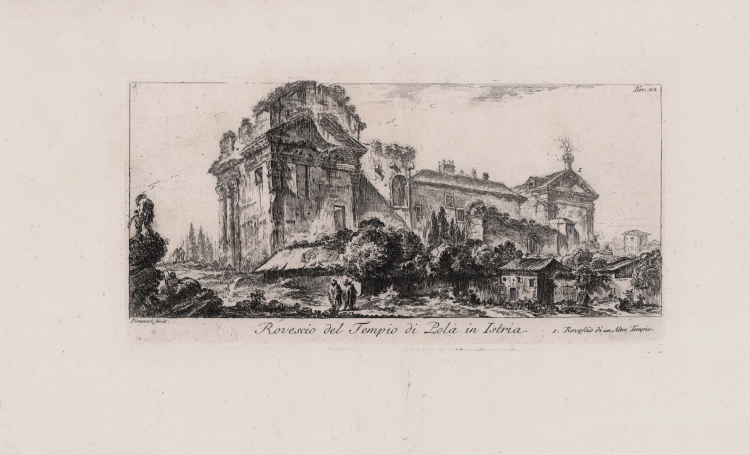



| Reference: | S19033 |
| Author | Giovan Battista PIRANESI |
| Year: | 1748 ca. |
| Zone: | Histria |
| Printed: | Rome |
| Measures: | 250 x 130 mm |


| Reference: | S19033 |
| Author | Giovan Battista PIRANESI |
| Year: | 1748 ca. |
| Zone: | Histria |
| Printed: | Rome |
| Measures: | 250 x 130 mm |
View taken from the famous Alcune Vedute di Archi Trionfali ed altri monumenti inalzati da Romani parte de quali se veggono in Roma e parte per l'Italia, first published in 1748.
Etching and engraving, ca. 1748, signed in plate at bottom.
Series of views taken from sketches Piranesi took in Rome and on his travels through Italy between 1743 and 1747; the first part depicts ancient remains inside the city and the second ruins visible outside. The first edition titled Antichità romane de' tempi della repubblica, e de' primi imperatori..., after 1761 was renamed Alcune vedute di archi trionfali ed altri monumenti...and was enriched with two more plates: Veduta dell'arco fabbricato in onore d'Augusto vicino alla città di Aosta (engraved by Piranesi from a drawing by Sir Roger Newdigate in 1775) and Tempio di Minerva Medica (by Francesco Piranesi). Compared to the first edition, some plates have changed in order and numbering and the engraving is reworked.
A very good example, of the contemporary Roma edition, with margins, in excellent condition.
Bibliografia
H. Focillon, Giovan Battista Piranesi 1720-1778 (1918): n. 61; J. Wilton-Ely, Giovan Battista Piranesi, The complete etchings (1994): n. 123; Le Blanc C., Manuel de l'amateur d'Estampes, 6, V. 3 P. 207, 1854-59; Nagler G.K., Neues Allgemeines Künstler-Lexikon, 5, V. 11 P. 360, 1835-52; C.A. Petrucci, Catalogo Generale Delle Stampe Tratte Dai Rami Incisi Posseduti Dalla Calcografia Nazionale, 368, P. 262, 1953.
Giovan Battista PIRANESI (Mogliano Veneto 1720 - Roma 1778)
|
Italian etcher, engraver, designer, architect, archaeologist and theorist. He is considered one of the supreme exponents of topographical engraving, but his lifelong preoccupation with architecture was fundamental to his art. Although few of his architectural designs were executed, he had a seminal influence on European Neo-classicism through personal contacts with architects, patrons and visiting artists in Rome over the course of nearly four decades. His prolific output of etched plates, which combined remarkable flights of imagination with a strongly practical understanding of ancient Roman technology, fostered a new and lasting perception of antiquity. He was also a designer of festival structures and stage sets, interior decoration and furniture, as well as a restorer of antiquities. The interaction of this rare combination of activities led him to highly original concepts of design, which were advocated in a body of influential theoretical writings. The ultimate legacy of his unique vision of Roman civilization was an imaginative interpretation and re-creation of the past, which inspired writers and poets as much as artists and designers.
|
Giovan Battista PIRANESI (Mogliano Veneto 1720 - Roma 1778)
|
Italian etcher, engraver, designer, architect, archaeologist and theorist. He is considered one of the supreme exponents of topographical engraving, but his lifelong preoccupation with architecture was fundamental to his art. Although few of his architectural designs were executed, he had a seminal influence on European Neo-classicism through personal contacts with architects, patrons and visiting artists in Rome over the course of nearly four decades. His prolific output of etched plates, which combined remarkable flights of imagination with a strongly practical understanding of ancient Roman technology, fostered a new and lasting perception of antiquity. He was also a designer of festival structures and stage sets, interior decoration and furniture, as well as a restorer of antiquities. The interaction of this rare combination of activities led him to highly original concepts of design, which were advocated in a body of influential theoretical writings. The ultimate legacy of his unique vision of Roman civilization was an imaginative interpretation and re-creation of the past, which inspired writers and poets as much as artists and designers.
|